5 MARCH 2012
YOUR WORDS
Readers are invited to add their comments to any story. Click on the article to see and add.
BTN DISTRIBUTION
BTN also goes out by email every Sunday night at midnight (UK time). To view this edition click here.
- ON THE SOAPBOX: Unite… and aviation will fly says Darren Caplan
- More strikes at Iberia
- Abu Dhabi to Shanghai
- Air Astana takes the Boeing 767/787 route
- Air France summer programme
- All very quiet on Virgin
- Aviation Consultation by the UK Government
- Boeing delivers first passenger747-8
- Cathay puts new seats into service
- CNN Business Traveller returns
- Continental Airlines says goodbye
- Embraer 190 goes Business Class with Virgin Australia
- Frankfurt Airport strike
- Heathrow Terminal 2 topped out
- IAG (BA & Iberia) annual figures
- London Mayoral candidate calls for third Heathrow runway
- Luton Airport and Adria
- Mint Bristol now a Hilton
- OAG airport review
- Orbis celebrates 30 years of saving sight
- Routemaster returns
- ON TOUR: Stuck at Heathrow – or thinking of a weekend break
- AND FINALLY: Concorde was very quiet
The Business Travel News
PO Box 758
Edgware HA8 4QF
United Kingdom
info@btnews.co.uk
© 2022 Business Travel News Ltd.
Abu Dhabi to Shanghai
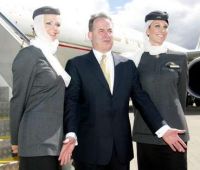 Etihad Airways, the national airline of the United Arab Emirates (UAE), has commenced scheduled flights between its hub in Abu Dhabi and Shanghai (China).
Etihad Airways, the national airline of the United Arab Emirates (UAE), has commenced scheduled flights between its hub in Abu Dhabi and Shanghai (China).
The airline will initially operate five weekly Airbus A330-300 services to Shanghai’s main international airport – Pudong (PVG) – with commitments to a daily schedule from 15 April.
The President and Chief Executive Officer of Etihad Airways, James Hogan, said that the new route had special significance as the first non-stop commercial passenger flight between Abu Dhabi and Shanghai.
“The new Shanghai route adds much more than just another destination to the Etihad Airways global network.
It brings the capital of the UAE and the commercial and financial centre of mainland China closer together and creates new opportunities for government, trade, tourism and cultural exchange.”
Flight time is around eight hours. The airline will compete with Emirates, whose home base is at Dubai, just 70 miles, or less than two hours, along the coastal highway. Emirates is established and is daily with an Airbus A380 on the route.
Mr Hogan also noted that the Abu Dhabi – Shanghai route was the only one in Etihad’s China network to offer a three-class aircraft with First, Business and Economy cabins. www.etihad.com
All very quiet on Virgin
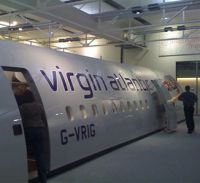 Virgin Atlantic has appointed its first ever 'whispering coach' to ensure that all passengers using the airline's new Upper Class Dream Suite enjoy the most relaxing night's sleep possible.
Virgin Atlantic has appointed its first ever 'whispering coach' to ensure that all passengers using the airline's new Upper Class Dream Suite enjoy the most relaxing night's sleep possible.
The new training, which takes an extra day to master, has been added to the existing service training which Virgin Atlantic's Upper Class cabin crew go though. Crew learn the best ways to engage with passengers – ensuring they experience unrivalled hospitality at 35,000ft. Cabin crew training already includes master classes based on a 'Brilliant Basics, Magic Touches' ethos and includes tips on how to read passengers, being tactile and how to wake people comfortably.
Virgin Atlantic's Richard Fitzgerald has taken on the role of Virgin Atlantic's Whispering Coach to train the crew for the launch of the new Suite in spring 2012 – and will be providing invaluable training to cabin crew tending to passengers in the airline's new Upper Class Dream Suite. Yet to be unveiled it is claimed to offer the largest and most comfortable beds in the sky. The crew are now trained to whisper at tones between 20 and 30 decibels due to its calming effect and the fact that it will not disturb other passengers whilst lights are out. www.virgin-atlantic.com
Cathay puts new seats into service
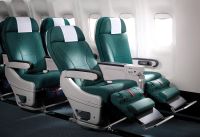 Hong Kong has seen the arrival of Cathay Pacific’s first Boeing 777-300ER featuring its new Premium Economy Class product and long haul Economy Class seats.
Hong Kong has seen the arrival of Cathay Pacific’s first Boeing 777-300ER featuring its new Premium Economy Class product and long haul Economy Class seats.
Speaking at the delivery ceremony at the Boeing factory in Seattle, Cathay Pacific Chief Operating Officer Ivan Chu said: “This is an important development for Cathay Pacific – another big step in our commitment to provide outstanding products and services to our passengers. We’re confident that both these new products will be winners, especially when combined with the famous Cathay Pacific service.”
The new Premium Economy experience features a quieter, more spacious cabin than the traditional Economy Class with between 26 and 34 seats per aircraft. The seat pitch is 38 inches – six inches more than Economy Class – and the seat itself is wider and has a bigger recline. It has a large meal table, cocktail table, footrest, a 10.6-inch personal television, an in-seat power outlet, a multi-port connector for personal devices and extra personal stowage space. There is an enhanced catering service too. www.cathaypacific.com
Embraer 190 goes Business Class with Virgin Australia
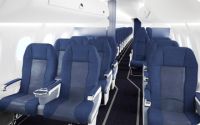 Virgin Australia is to introduce a Business Class on its Embraer E190 fleet later this year. The re-designed layout is 2+1 with new luxury leather seating creating a superior experience of privacy and comfort for guests. The cabin will offer just six seats at a 38” pitch with a fixed divider from Economy Class.
Virgin Australia is to introduce a Business Class on its Embraer E190 fleet later this year. The re-designed layout is 2+1 with new luxury leather seating creating a superior experience of privacy and comfort for guests. The cabin will offer just six seats at a 38” pitch with a fixed divider from Economy Class.
Virgin Australia Group Executive of Product and Service, Martin Daley, said that the new layout of the E190 fleet will enable Virgin Australia to cater to market demand for Business Class travel between key cities and regional destinations.
“The upgrade of the Business Class cabin in the E190 fleet will offer both privacy and comfort, whilst maintaining the service and product offering already in place across the network.”
Other features include a personalised service from a dedicated cabin crew member along with one class washroom facilities, Newspapers until noon daily, exclusive Luke Mangan gourmet service, premium Australian wine, beer, and spirit selection. Priority security screening, boarding and baggage service where available, complimentary access to Virgin Australia airport lounges. At Sydney Airport there is direct kerbside access into the lounge. www.virginaustralia.com
IAG (BA & Iberia) annual figures
 British Airways and Iberia’s parent company, IAG, has reported an increase in annual profits. The company made a pre-tax profit of £426 in 2011, the figure for the previous year was £70m.
British Airways and Iberia’s parent company, IAG, has reported an increase in annual profits. The company made a pre-tax profit of £426 in 2011, the figure for the previous year was £70m.
IAG's Chief Executive, Willie Walsh, used this announcement to once again criticise Government policy regarding APD (Airline Passenger Duty).
"The impact of these very high taxes – the highest in the world – is very negative on the UK economy and is destroying jobs," he said. Mr Walsh noted that BA was cutting recruitment by 500.
The airline also said it had reduced non-fuel costs by 5.6% last year and increased revenue per passenger by 3.6%.
Regarding Iberia strikes by pilots in response to plans to launch Iberia Express, a new low-cost carrier, Mr Walsh said they were costing the company about €2m during each day of industrial unrest.
Mr Walsh noted British Airways traffic this summer may be impacted by the Olympic games. While the Olympics will be positive for the long-term position of London as a global destination, past experience in other host cities suggests that demand could be dampened.
IAG will not be paying a dividend. www.iairgroup.com
Mint Bristol now a Hilton
 Hilton is getting on very quickly with rebranding the raft of Mint Hotels recently acquired as Garden Inns with Bristol the latest opening. The Hilton Garden Inn Bristol City Centre is near Temple Meads station and opposite the main business district. Close by is the Cabot Circus shopping area as well as the city’s historic harbour side. It is part of a wider Hilton Garden Inn portfolio expansion which also includes new openings in Glasgow and Birmingham.
Hilton is getting on very quickly with rebranding the raft of Mint Hotels recently acquired as Garden Inns with Bristol the latest opening. The Hilton Garden Inn Bristol City Centre is near Temple Meads station and opposite the main business district. Close by is the Cabot Circus shopping area as well as the city’s historic harbour side. It is part of a wider Hilton Garden Inn portfolio expansion which also includes new openings in Glasgow and Birmingham.
Simon Vincent, Area President, Europe, Hilton Worldwide, said: “Across Europe our Hilton Garden Inn brand is represented in more than 20 locations in six countries. We are delighted to now be welcoming guests to Hilton Garden Inn in Bristol, which joins the mid-market brand’s UK hotels open in Aberdeen and Luton. We have now more than doubled the number of Hilton Garden Inn hotels in the UK, providing guests with greater Hilton Worldwide mid-market choice.”
Hilton Garden Inn Bristol City Centre features 167 rooms with spectacular city views and excellent facilities for business and leisure guests. Complimentary wi-fi access is provided. The hotel offers a fitness studio, meeting space for up to 60 people, a unique butler service button and an Apple iMac in each room. http://hiltongardeninn1.hilton.com
Routemaster returns
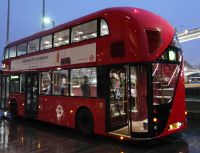 London’s iconic double deck red bus Routemaster is making a comeback. The first of a new fleet of 21st century models was introduced last week on route 38 between Victoria Station and Hackney in East London. It replaces the unpopular Bendy Bus.
London’s iconic double deck red bus Routemaster is making a comeback. The first of a new fleet of 21st century models was introduced last week on route 38 between Victoria Station and Hackney in East London. It replaces the unpopular Bendy Bus.
The current Mayor of London, Boris Johnson, first announced his intention to create a new bus in the run up to the 2008 Mayoral election which he won. Another election is due 3 May this year.
A competition was launched in July 2008 that sought to harvest design ideas for a new bus for London that drew inspiration from the iconic Routemaster but was fit for the 21st century. This would be the first time a bus had been designed specifically for the streets of London in more than 50 years. The competition was a huge success with more than 700 entries received from professionals and non-professionals of all ages from five continents.
The new bus has a host of exciting and innovative features including three entrances and two staircases to enable fast boarding and alighting of passengers; the reintroduction of an open rear platform; LED lighting; new seating moquette and wireless bell pushes. www.tfl.gov.uk/buses
ON THE SOAPBOX: Unite… and aviation will fly says Darren Caplan
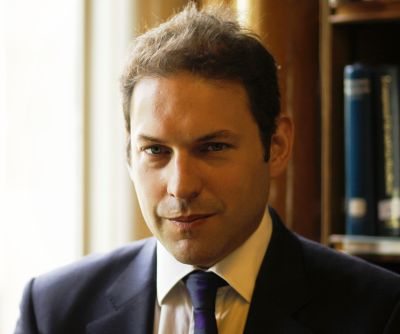 Darren Caplan has been Chief Executive of the Airport Operators Association since January 2011. Previously, he spent 14 years working in communications, public affairs and politics across a number of sectors, including infrastructure, planning and technology.
Darren Caplan has been Chief Executive of the Airport Operators Association since January 2011. Previously, he spent 14 years working in communications, public affairs and politics across a number of sectors, including infrastructure, planning and technology.
He has worked for NTL, the Conservative Party, and multi-client lobbying/PR agencies in London; and stood (unsuccessfully!) as a parliamentary candidate against Diane Abbott in the 2010 general election.
Aviation is a fantastic industry. Airplanes and airports are inspiring in what they do and what they deliver. And what is more beautiful than an aeroplane rolling down a runway and then taking to the sky? Few industries represent the ability and achievement of mankind better than aviation. Yet few industries are so taken for granted.
Despite the fact that the UK is so good at this aviation thing – pioneers in air travel, with an incredibly strong pedigree in aerospace – and despite the fact that the most amazing, talented, people work in the industry, full of character and passion – we face a real battle against belligerent anti-aviation groups and complacent public policy-makers.
Some anti-aviation groups are local, campaigning against airport development despite the fact they often regularly use those very same airports. Some are national, viscerally against flying for any number of reasons. Despite being small in terms of operatives but loud in voice, they would rather see an aviation sector retreating in principle, than seek solutions to relatively short term challenges. These challenges mainly revolve around environmental impacts and noise, and I call them short term because the current generation of geniuses putting people up in to the skies are already developing solutions to them, building upon fantastic advances already delivered.
We also have public policy-makers who give undeserved weight to anti-aviation groups and who are subsequently unwittingly hindering this wonderful industry of ours. I say unwittingly because we know they want to create thousands more aerospace jobs, that they want the UK to become a Top 5 tourist destination, and that they want the country to be “Open for business” – the charge on all this has been led by the Prime Minister himself! In which case you have to wonder why the Government has levied the highest Air Passenger Duty (APD) taxes in the world, has allowed a three-year aviation policy black hole, and is still considering unilateral carbon budgeting or targets when the UK has just joined a continental (European) Emissions Trading Scheme.
Despite all this, the Airport Operators Association and many others in aviation are optimistic about the future. But to deliver on that optimism everyone in the industry needs to unite, otherwise we make it easy for those who wish to do our industry down. So whether campaigning for fairer, lower APD via A Fair Tax on Flying (www.facebook.com/afairtaxonflying), or promoting environmental and noise initiatives such as Sustainable Aviation (www.sustainableaviation.org.uk), now is not the time to just simply fight your corner. Rather – in this final full year before the Sustainable Framework for UK Aviation is devised and adopted – now is the time to stand together and fight to establish aviation as an essential help, and not a hindrance, to the future success of UK plc.
This is the message that Ed Anderson, AOA Chairman, will deliver to tonight’s AOA Annual Dinner, at which Transport Secretary Justine Greening will be in attendance. This is the message policy-makers will receive at the Sustainable Aviation Road-Map launch in the House of Commons tomorrow, when we demonstrate aviation really can deliver both growth and environmental impact curbs. And this is the message that the Chancellor will be hearing loud and clear from the Fair Tax on Flying coalition later this month ahead of the Treasury’s implementation of a punitive double inflation APD rise for 2012/13 and another inflation tax-increasing Budget for the year after that.
We are on the right side of these aviation debates. Anti-aviation opponents do not represent the great majority of people in this country who fly and/or benefit from the advantages a connected air network brings. Policy-makers are not necessarily set in their ways, as evidenced by the Treasury freezing APD last year (following energetic, united, campaigning) in last March’s Budget, and its inclusion of aviation in the National Infrastructure Plan in November, following many months when the Government would only talk of roads, rail and ships as key national infrastructure.
As I sit under the flightpath where I live, watching planes descending gracefully from the clouds to come into land (yes, I really do do this!), wondering where their cargo of holidaymakers, business people, loved-ones on family trips and high value belly-hold freight have journeyed from, it seems to me that aviation’s best days can still be ahead. Anti-aviation campaigners and complacent governments will come and go, but flying is here to stay. However, we must join forces as an industry and fight the good fight in this crucial lobbying year if both the aviation industry and the country it serves are to flourish in these tough economic times. I look forward to joining you on the campaign trail, as we unite to ensure aviation can progress from merely taxiing to take-off in the years ahead.
Darren Caplan
Air Astana takes the Boeing 767/787 route
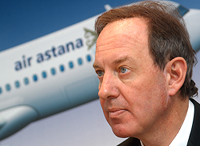 Boeing and Air Astana have announced an order for four 767-300ERs and three 787-8s. The airline, jointly owned by the Government of Kazakhstan and BAe Systems, was established in 2002 and currently operates a fleet of 26 aircraft including Fokker 50, Embraer 190, Airbus A320 series, and both the Boeing 757 and 767
Boeing and Air Astana have announced an order for four 767-300ERs and three 787-8s. The airline, jointly owned by the Government of Kazakhstan and BAe Systems, was established in 2002 and currently operates a fleet of 26 aircraft including Fokker 50, Embraer 190, Airbus A320 series, and both the Boeing 757 and 767
"Our decision to order the Boeing airplanes is part of Air Astana's long-term growth strategy to expand and modernize our fleet with newer, more fuel-efficient airplanes to serve domestic, regional and international routes," said Peter Foster, President, Air Astana. "In addition, we want to offer an enhanced travel experience for our customers which we shall be able to do on these airplanes."
On the London route Air Astana is twice weekly for the eight hour service. If BA take over bmi, who offer the same frequency, it will be interesting to see their future plans.
Boeing’s order book for the 767 stands at around 1,300 including 178 of the tanker version for the US military. Whilst the Air Astana order will be amongst the last for the aircraft the much later 777 continues to sell with 1,361 commitments, the 1000th model rolled out last week. www.boeing.com/commercial
Aviation Consultation by the UK Government
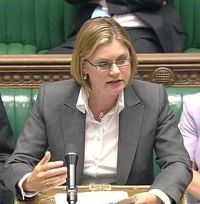 A statement from the Department for Transport would seem to indicate an internal review of the Government’s air transport policy and clearly an acknowledgement of its importance to the UK economic performance. Asked by AERBT regarding Westminster rumours that the aviation consultative document due to be published towards the end of March would be split into two a spokesman said:
A statement from the Department for Transport would seem to indicate an internal review of the Government’s air transport policy and clearly an acknowledgement of its importance to the UK economic performance. Asked by AERBT regarding Westminster rumours that the aviation consultative document due to be published towards the end of March would be split into two a spokesman said:
"As the Chancellor made clear in his Autumn Statement, we will explore all the options for maintaining the UK's aviation hub status with the exception of a third runway at Heathrow. The Government will consult on an overarching sustainable framework for UK aviation this spring and alongside this we will publish a call for evidence on maintaining effective UK hub airport connectivity.”
Within the airline industry the call seems to be that what is urgently wanted is a firm airport policy, one that all can get behind. Clearly there will be contradictory opinions but unless a way ahead is focussed upon Britain will lose out in the chase for international airline business and the immense benefits it brings. www.dft.gov.uk
CNN Business Traveller returns
 Thursday 15 March sees the return of CNN Business Traveller hosted by the indefatigable Richard Quest.
Thursday 15 March sees the return of CNN Business Traveller hosted by the indefatigable Richard Quest.
Each month, Quest will present the show from hotels, airports and cities around the world, bringing his detailed knowledge of surviving out of a suitcase on the world’s corporate highways and byways. Joining him will be resident business travel news correspondent Ayesha Durgahee.
“Since CNN Business Traveller has been away, tough economic times have continued, but so has business travel. I’m delighted that once again, CNN is able to inspire viewers to profit from their travels and broaden their horizons, both in terms of personal enjoyment and business opportunities. This is a fascinating industry – we look forward to the year ahead on the road,” said Matt Percival, Executive Editor, CNN International.
In the first programme, airing 07:30 GMT Thursday 15 March, Quest is in Singapore to celebrate business travel in a region where growth is rife and trends are set. With the economic winds blowing eastwards, Changi Airport is a thriving hub battling for supremacy among Asia’s high-tech airports; it was also the location of the first ever episode of ‘CNN Business Traveller’ so it is a fitting place for the programme to return to in 2012. www.cnn.com/businesstraveller (goes live on Wednesday, 7 March).
Frankfurt Airport strike
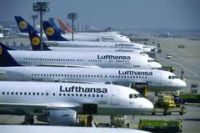 Readers should take care if passing through Frankfurt Airport during the next period. Due to industrial action by ground staff last week just over 1,000 flights have been cancelled since Thursday. The vast majority of these were Lufthansa, which has mostly scrapped European services to give priority to intercontinental passengers.
Readers should take care if passing through Frankfurt Airport during the next period. Due to industrial action by ground staff last week just over 1,000 flights have been cancelled since Thursday. The vast majority of these were Lufthansa, which has mostly scrapped European services to give priority to intercontinental passengers.
The GdF trade union said in a statement that the strike would start at 20:00 GMT Sunday 26 February until 04:00 GMT on Thursday 1 March.
Frankfurt Airport is Europe's third-busiest after Heathrow and Charles de Gaulle, with about 1,300 flight movements per day, more than half of them by Lufthansa.
A spokesman for Lufthansa said that, like with the previous walkouts, long haul flights would be given priority and a list of Monday's flight cancellations is now available on its website. Lufthansa was the worst hit by the strikes that started on 16 February and initially ran until 22 February.
Frankfurt Airport has been using former ground crew to replace striking workers, with the number of flight cancellations dropping each day as staff became used to the role again. www.lufthansa.com
London Mayoral candidate calls for third Heathrow runway
 Siobhan Benita, who is standing as an Independent candidate in the forthcoming election for London Mayor, is today calling for the building of a third runway at Heathrow to be put back on the agenda and given the go-ahead by the Government. Incumbent Boris Johnson says an airport in the Thames Estuary could be the answer whilst main rival Ken Livingstone does not seem to have a policy.
Siobhan Benita, who is standing as an Independent candidate in the forthcoming election for London Mayor, is today calling for the building of a third runway at Heathrow to be put back on the agenda and given the go-ahead by the Government. Incumbent Boris Johnson says an airport in the Thames Estuary could be the answer whilst main rival Ken Livingstone does not seem to have a policy.
Ms Benita said: “London and its population would be best served with another runway at Heathrow. It will not only bring new jobs to the west of the city, but also be built more quickly than the fantasy project already proposed by the party political mayor. We are stuck with the location of Heathrow whether we like it or not – now is the time to invest in it and bring more connections and greater prosperity to London as result.”
Heathrow Airport is unable to grow as the existing two runways are fully utilised and the airport is close to capacity.
“The environmental concerns remain and, as Mayor of London, I would work with BAA on ensuring the runway is situated in the best position to cause the least noise and pollution to surrounding communities.” www.siobhanformayor.com
OAG airport review
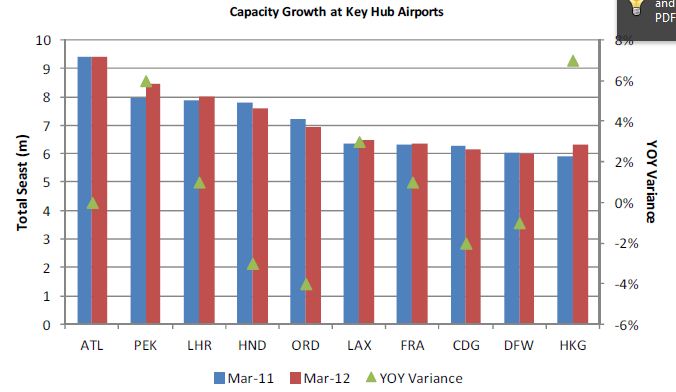
OAG says that although the trend towards increases in capacity and frequency is encouraging, from a regional perspective the picture is somewhat mixed and significant variations exist. The Middle East is the region which commands the highest level of increase in capacity and frequency where OAG notes a 9% increase in frequency and an increase of 10% in capacity.
Capacity within North America sees a decline of 1% suggesting the continuation of difficult trading conditions as a consequence of the global economic downturn. Frequencies within North America have also declined by 3% an overall contraction of the market albeit the majority arguably being attributable to changes in the schedules of American Airlines as the carrier enters Chapter 11.
For March Beijing Airport anticipates an increase in capacity of 6%. www.oag.com
ON TOUR: Stuck at Heathrow – or thinking of a weekend break
 Let’s face it, if you are stuck at Heathrow for some reason for 24/48 hours nearby there is the world’s greatest selection of ‘what to do’. You can go into London or take advantage of some of the most absorbing countryside anywhere in the world. The choice is simply enormous.
Let’s face it, if you are stuck at Heathrow for some reason for 24/48 hours nearby there is the world’s greatest selection of ‘what to do’. You can go into London or take advantage of some of the most absorbing countryside anywhere in the world. The choice is simply enormous.
Here is a suggestion. It is somewhat Victorian regarding venues, but as you will learn some of our forebears lived very well.
Make for Aylesbury less than one hour away by road. You can gamble that the M25 is clear and onto the A41M or take the pretty and much shorter cross country route via Great Missenden and Amersham.
Your base for one or two nights is Hartwell House on the Oxford Road just outside the town. It is owned by the National Trust and was once the residency of Louis XVIII, never crowned as King of France, who lived there with his Court for five years.
Situated in 90 acres of landscaped parkland, Hartwell House offers a splendid country house setting. It provides for a long (or short) walk, country pursuits, and a fine spa with an exquisite swimming pool that opens out onto a private veranda. For an ‘away from it all’ company conference, within easy access of London and Heathrow, it is ideal.
 The impressive Grade I listed house, which has both Jacobean and Georgian facades, contains a host of most beautiful rooms with rococo ceilings, antique furniture and paintings, yet with every imaginable contemporary comfort. The bedrooms follow the same style, but internet is provided too. Dine is style in the restaurant or take tea in one of the large and historic public rooms with friends. In a classic style is the Hartwell House spa with a first class gym, the indoor pool and small café. The grounds are extensive, laid out by Capability Brown, one of Britain’s finest ever landscape artists.
The impressive Grade I listed house, which has both Jacobean and Georgian facades, contains a host of most beautiful rooms with rococo ceilings, antique furniture and paintings, yet with every imaginable contemporary comfort. The bedrooms follow the same style, but internet is provided too. Dine is style in the restaurant or take tea in one of the large and historic public rooms with friends. In a classic style is the Hartwell House spa with a first class gym, the indoor pool and small café. The grounds are extensive, laid out by Capability Brown, one of Britain’s finest ever landscape artists.
Hartwell House is central for two fascinating yet completely different late Victorian properties. Both the owners were very powerful men whose backgrounds were not that far apart, but clearly had completely different views on what a home should be.
Waddesdon Manor
 The residence of Baron Ferdinand de Rothschild (1839-1898), Waddesdon Manor is one of the great country houses of England. It was built by the Baron in the Neo-Renaissance style of a French château between 1874 and 1889. In 1957 James de Rothschild bequeathed the house and its contents to the National Trust. Today it is as immaculate as ever, a living tribute to the family (who still take a great interest) and the Trust who run it on a day to day basis.
The residence of Baron Ferdinand de Rothschild (1839-1898), Waddesdon Manor is one of the great country houses of England. It was built by the Baron in the Neo-Renaissance style of a French château between 1874 and 1889. In 1957 James de Rothschild bequeathed the house and its contents to the National Trust. Today it is as immaculate as ever, a living tribute to the family (who still take a great interest) and the Trust who run it on a day to day basis.
In its time Waddesdon was one of the fashionable social centres of the country famed for its entertainment and art collection.
The Waddesdon Collection is astonishing and comes from all over Europe. The Musical Automaton actually works and is priceless. As you explore the three floors of the main house open to the public one begins to appreciate that the mega rich of today certainly had their contemporaries in an earlier era. One extravagant piece of furniture after another. Paintings by the great Dutch artists and also modern works. The collection does not stand still.
 Waddesdon Manor can claim to be one of the first buildings of any size to have electricity. In 1890 Queen Victoria was most impressed by the invention she had not seen before. She was reported to have spent ten minutes switching a newly electrified 18th century chandelier on and off.
Waddesdon Manor can claim to be one of the first buildings of any size to have electricity. In 1890 Queen Victoria was most impressed by the invention she had not seen before. She was reported to have spent ten minutes switching a newly electrified 18th century chandelier on and off.
You really need a whole day to get around the park, aviary and stables. A courtesy passenger tractor ride is available and the eating arrangements range from the Manor Restaurant in the Old Kitchen and Servants' Hall, to the very pleasant Stables Café. There is a continuous programme of events and free guided tours of the house for visitors.
Cut into the side of a hill is the amazing Woodland playground. It winds through the trees making use of the natural environment to create a fun and magical area to play. Rope swings, see saws, bird's nest swing and contour slide let children run and climb, swing and slide. Different areas are set out for varying ages, suitable up to 14 years.
Hughenden
 Hughenden Manor, just outside High Wycombe, is something else. As the home of a British Prime Minister (Benjamin Disraeli) it can be compared to Chartwell in Kent, Churchill’s residence. Its connection with Waddesdon is interesting. Queen Victoria visited each of the Buckinghamshire residences. She seems to have been amused with both. It is again owned by the National Trust, like Waddesdon bequeathed through a family trust. Neither Rothschild nor Disraeli had children. Like its contemporary 20 miles to the north west the house and grounds are kept immaculate.
Hughenden Manor, just outside High Wycombe, is something else. As the home of a British Prime Minister (Benjamin Disraeli) it can be compared to Chartwell in Kent, Churchill’s residence. Its connection with Waddesdon is interesting. Queen Victoria visited each of the Buckinghamshire residences. She seems to have been amused with both. It is again owned by the National Trust, like Waddesdon bequeathed through a family trust. Neither Rothschild nor Disraeli had children. Like its contemporary 20 miles to the north west the house and grounds are kept immaculate.
Born in 1804 Disraeli died in 1881. He was Prime Minster for two periods as leader of the Conservative Party. Charismatic, he was well known as a literary and social figure famous for charming his Queen. As a writer his best known novel is Sybil which traces the plight of the working classes of England.
Whilst Hughenden as a 19th century country house is interesting it cannot be compared with size and grandeur to Waddesdon Manor. There is a lovely formal garden, some pleasant walks and both Disraeli and his wife Mary Anne (who predeceased him) are buried in the nearby St Michaels and All Angels Church.
 The present house was built towards the end of the 18th century and was of a stuccoed and of unassuming design. In 1848 the Disraelis purchased the property but it was not until 1862 that they had it remodelled by the architect Edward Buckton Lamb. Today it is set out in much the same style as it would have been in the later 19th century with Disraeli’s study intact.
The present house was built towards the end of the 18th century and was of a stuccoed and of unassuming design. In 1848 the Disraelis purchased the property but it was not until 1862 that they had it remodelled by the architect Edward Buckton Lamb. Today it is set out in much the same style as it would have been in the later 19th century with Disraeli’s study intact.
There is further connection with Waddesdon Manor. It was to another Rothschild, Baron David, that Disraeli turned to in 1874 for a short-term loan to purchase 44% of the Suez Canal. Britain’s route to its Eastern Empire was secure.
During the WWII, Hughenden Manor was used as a secret intelligence base code-named "Hillside". The UK Air Ministry staff at the manor analysed aerial photography of Germany and created maps for bombing missions, including the famous "Dambusters" raid. There is a small museum in the basement of the house.
http://www.hartwell-house.com www.waddesdon.org.uk www.nationaltrust.org.uk/hughenden
More strikes at Iberia
Readers to and from Spain should note that Iberia pilots have called for 24 separate days of strikes including the busy Easter holiday week. This is in retaliation for the launch of Iberia Express, due to make its maiden flight 25 March. The only good news is that the date coincides with the move of Iberia to Heathrow T5, which should alleviate the problems of changing terminals, if you can find a BA seat! www.iberia.com
Air France summer programme
 Summer capacity on offer by the Air France/KLM is to rise by just 0.6%. It said that capacity will be raised by 0.8% on long haul routes but will be trimmed by 0.2% to medium-range destinations, excluding operations that the airline is developing from regional bases in the French cities of Marseille, Toulouse and Nice. However these are marginal with just 3% more seats available.
Summer capacity on offer by the Air France/KLM is to rise by just 0.6%. It said that capacity will be raised by 0.8% on long haul routes but will be trimmed by 0.2% to medium-range destinations, excluding operations that the airline is developing from regional bases in the French cities of Marseille, Toulouse and Nice. However these are marginal with just 3% more seats available.
Air France said that, in coordination with its partners Delta Airlines and Alitalia, it is slashing its seat capacity on North American routes by 6.5% over the summer.
The French flag carrier, which is struggling to return to profitability, said that it is suspending its flights to Seattle, which will be taken over by Delta, and to Newark, the alternative New York airport, from the beginning of the summer. Orlando goes in September.
Smaller aircraft will be used on the Paris to Miami and Toronto route. From 28 May 2012 one of Air France’s two daily services to Los Angeles will be upgraded to an A380, making it the third US destination served with the Super Jumbo. However the weekly flights will be reduced from 20 to 15. www.airfrance.com
Boeing delivers first passenger747-8
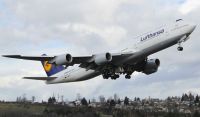 The photo is somewhat misleading but Boeing has delivered the first passenger 747-8, a VIP aircraft to an undisclosed client who will install his own interior. The aircraft is not expected into service until 2014. Boeing have a further eight similar aircraft on order. This particular plane will feature Greenpoint Technologies Aeroloft, located above the main cabin between the upper deck and tail. In total there is an astonishing 5,179sq ft (481.1sq m) of cabin space.
The photo is somewhat misleading but Boeing has delivered the first passenger 747-8, a VIP aircraft to an undisclosed client who will install his own interior. The aircraft is not expected into service until 2014. Boeing have a further eight similar aircraft on order. This particular plane will feature Greenpoint Technologies Aeroloft, located above the main cabin between the upper deck and tail. In total there is an astonishing 5,179sq ft (481.1sq m) of cabin space.
Deliveries continue of the 747-8 freighter, two with Cargolux, three Atlas Air, one Volgo Dnvpr, and four Cathay Pacific.
Seen taking off on a flight test at Seattle is the first airline passenger plane, destined for Lufthansa, dubbed 747-8 Intercontinental. Whilst details have not been made public it is thought to have around 470 seats in a three-class layout. No ‘in service’ date has been announced.
In total Boeing has 106 747-8s on order of all three variants. Discussions have been known to have taken place in changing the current US Air Force One (in fact two elderly 747-200s) but this will not happen until 2017. www.boeing.com/commercial
Continental Airlines says goodbye
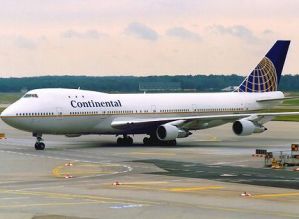 This will probably be the last time that AERBT mentions Continental Airlines, which has been around since 1937, and whose forbears go back to at least 1934.
This will probably be the last time that AERBT mentions Continental Airlines, which has been around since 1937, and whose forbears go back to at least 1934.
The public face of the airline vanished for good last weekend when the carrier and United Airlines adopted a single passenger reservation system, a step that – at least in the public eye – finally cementing their 2010 merger.
The move to a unified platform is by far the most significant change customers will experience since the merger of United and Continental to form the world's largest airline, known as United Airlines and owned by United Continental Holdings Inc. "This, from the customer perspective, is probably the biggest thing that they will see," Martin Hand, United's Senior Vice President of Customer Experience, said on Wednesday.
Hand said that the company chose the Continental platform over United partly because it offered more flexibility to users making reservations on the site.
United Continental has painted most of the old Continental planes in the new combined livery and is finishing the rest. If you tap in the old Continental web site out of force of habit you will be re-directed. www.united.com
Heathrow Terminal 2 topped out
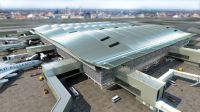 Transport Minister Justine Greening was on hand to help ‘top out’ the all-new Heathrow T2 last Wednesday (29 February) prior to work starting in earnest on the internal furnishings. The building will be the home of Star Alliance at the airport. She has recently been at Gatwick, Stansted and will next week officially open the new Southend terminal.
Transport Minister Justine Greening was on hand to help ‘top out’ the all-new Heathrow T2 last Wednesday (29 February) prior to work starting in earnest on the internal furnishings. The building will be the home of Star Alliance at the airport. She has recently been at Gatwick, Stansted and will next week officially open the new Southend terminal.
To minimise disruption to passengers, construction of Terminal 2 is taking place in two phases. The first phase will see the creation of the main terminal on the site of the old Terminal 2 and Queen's Building. It also involves the construction of a satellite terminal with additional aircraft parking stands and passenger gates called Terminal 2B. This first phase is due to open to passengers in 2014.
Phase two includes the construction of a second satellite building, T2C, which will increase the capacity of Terminal 2 from 20 to 30 million passengers a year.
The main terminal building – T2A – will have 12 aircraft stands. The satellite building – T2B (connected to T2A via an underground walkway) – will have 16 aircraft stands. Available are 60 self-service kiosks and 60 fast bag drops – which can be easily configured for traditional use. There are 17 security lanes and 56 traditional check-in lanes. www.baa.com
Luton Airport and Adria
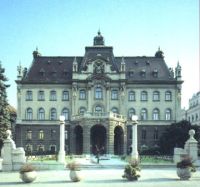 Adria Airways was in the UK last week promoting its new four times per week Luton to Ljubljana service first announced back in January. The airline pulled out of Gatwick at the beginning of the winter season without giving a reason but at a press conference in the private area of the Luton airside lounge the logic of the move became apparent. According to Adria the 50-seat Bombardier CRJ was not viable. At Luton a 135-seat Airbus A319 will be used and the airline will be selling onward connections to Podgorica, Pristina, Sarajevo, Skopje and Tirana. The airline competes with a three times per week easyJet Stansted service.
Adria Airways was in the UK last week promoting its new four times per week Luton to Ljubljana service first announced back in January. The airline pulled out of Gatwick at the beginning of the winter season without giving a reason but at a press conference in the private area of the Luton airside lounge the logic of the move became apparent. According to Adria the 50-seat Bombardier CRJ was not viable. At Luton a 135-seat Airbus A319 will be used and the airline will be selling onward connections to Podgorica, Pristina, Sarajevo, Skopje and Tirana. The airline competes with a three times per week easyJet Stansted service.
Created in the former Yugoslavia in 1961 today Adria is the Slovenian national carrier and for the most part state-owned. When the daily flights begin on 28 March it will become the first Star Alliance member airline to operate into Luton. Adria makes it clear that is not a low cost airline in the accepted sense offering both a “Priority Lane” and “Executive Lounge” facility to all passengers. www.adria.si
Orbis celebrates 30 years of saving sight
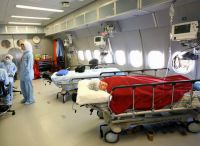 Its now somewhat elderly DC10 has become a familiar airport sight since it went into service in 1992 but it was in March 1982, that the Orbis Flying Eye Hospital took to the skies to deliver treatment and teaching to developing countries. Orbis International is an international non-profit non-governmental organisation (NGO) dedicated to saving sight worldwide. The aviation industry can be proud of the way it has helped Orbis to provide treatment for more than 15m blind and visually impaired people over 30 years. Programmes have been carried out in 89 countries enhancing the skills of more than 280,000 eye care professionals.
Its now somewhat elderly DC10 has become a familiar airport sight since it went into service in 1992 but it was in March 1982, that the Orbis Flying Eye Hospital took to the skies to deliver treatment and teaching to developing countries. Orbis International is an international non-profit non-governmental organisation (NGO) dedicated to saving sight worldwide. The aviation industry can be proud of the way it has helped Orbis to provide treatment for more than 15m blind and visually impaired people over 30 years. Programmes have been carried out in 89 countries enhancing the skills of more than 280,000 eye care professionals.
The Orbis Flying Eye Hospital was the second DC-10 aircraft built, in 1970. It was used as a test aircraft by McDonnell Douglas, and then was acquired for passenger service by Laker Airways. Last August Fedex announced that it would donate one of its MD-10-30Fs to Orbis to replace the DC10. The new MD-10 will feature a modular hospital suite, the first time these units will have been used on an aircraft, plus a lecture/teaching area. www.orbis.org
AND FINALLY: Concorde was very quiet
Following last week's COMMENT column “Noise – Let’s get a balanced view” one is reminded of a story going the rounds about 30 years ago. We can’t actually verify it but it does sound true.
“When Concorde was being introduced there was a practice flight to Heathrow. The antis distributed postcards, addressed to the government, to the residents around Heathrow for them to post if they found the noise unacceptable. A large percentage of the postcards received were, according to the postmarks, posted before the aircraft arrived”.
And also with the Airport Operators Association's dinner in mind!


